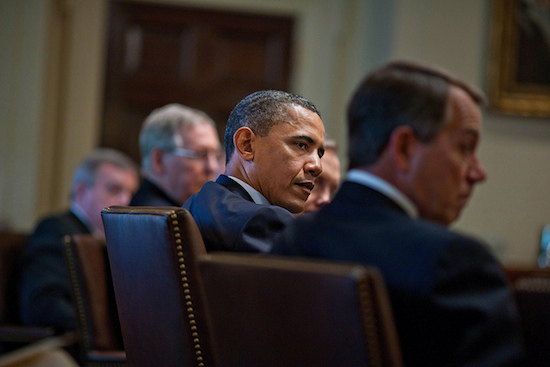
Prior to a meeting with his cabinet earlier this week, President Obama made a threat.
With a portrait of George Washington looking down at him, Obama told reporters gathered in the Cabinet Room of the White House Tuesday that while Congress is busy with a number of bills at the start of 2014, “We are not just going to be waiting for a legislation in order to make sure that we’re providing Americans the kind of help that they need.”
“I’ve got a pen and I’ve got a phone,” Obama said, “and I can use that pen to sign executive orders and take executive actions and administrative actions that move the ball forward in helping to make sure our kids are getting the best education possible and making sure that our businesses are getting the kind of support and help they need to grow and advance to make sure that people are getting the skills that they need to get those jobs that our businesses are creating.”
Obama is not the first American president to find himself frustrated with Congress, nor is he the first to threaten executive action as his legislative priorities remain blocked by the party of the opposition. Beginning with Washington himself, nearly every president has issued at least one executive order, with some going upwards of 1,000. (Franklin Roosevelt signed a whopping 3,728 during his 12 years in office.)
Obama, however, finds himself in a precarious situation. Having been elected twice by an organized but wildly diverse base, Obama has been besieged by those who voted for him in 2008 and 2012, but who haven’t seen him deliver on all of his promises.
For nearly two years Obama’s White House has been forced to defend a broken promise to the LGBT community. It was in April 2012 that White House senior adviser Valerie Jarrett told leaders from some of the nation’s largest LGBT-rights organizations that Obama would not sign an executive order prohibiting federal contractors from discrimination on the basis of sexual orientation or gender identity. The revelation was a major and unexpected blow to advocates, who had long sought the order and who thought Obama, having promised to sign such an executive order as a candidate for president in 2008, would deliver.
Since that meeting, the White House has sought to defend its decision by telling supporters and the press that Obama supports passage of comprehensive federal legislation — the Employment Non-Discrimination Act (ENDA) — that will protect all workers, rather than just employees of federal contractors. That argument hasn’t sat well with LGBT activists, who have been some of the president’s most passionate defenders. They too support ENDA, but argue signing an executive order is a tangible step forward the president could take now.
It seemed the White House, as well as press secretary Jay Carney, who frequently fields questions on the executive order from mainstream and LGBT media outlets, might finally catch a break last November when ENDA cleared the Senate with a bipartisan 64-32 vote. But nearly as soon as the vote had been tallied in the Senate, House Speaker John Boehner announced his opposition to the bill, nearly guaranteeing the bill won’t even be brought up for a vote in the Republican-controlled House of Representatives.
While lobbying in the House, virtually all of the bill’s supporters inside and outside of Congress insist Obama could take action today to protect 20 percent of the workforce with just the flick of his pen. Indeed, since April 2012, when Jarrett announced there would be no executive order from the president, Obama has signed about 50 other executive orders on a range of issues.
With each order he signs, Obama runs the risk of alienating one group or another for acting on a particular issue over another — whether it be on such high-profile issues as immigration reform, gun control or LGBT workplace discrimination. During a speech at a Democratic National Committee event in California this past November, Obama was interrupted by a heckler calling on him to take executive action on what appeared to be immigration reform.
“I’m going to actually pause on this issue because a lot of people have been saying this lately on every problem which is just sign an executive order, and we can pretty much do anything and basically nullify Congress,” Obama told the crowd. “And unfortunately that’s not how it works. We got this Constitution. We got this whole thing about separation of powers and branches. There is no shortcut to politics. And there’s no shortcut to democracy. And we have to win on the merits of the argument with the American people. As laborious as it seems sometimes, as much misinformation as there is out there sometimes, as frustrating as it may be sometimes, what we have to do is just keep on going, keep on pushing. And eventually, we move in a better direction.”
“That’s been true for the first five years of my administration,” Obama continued. “When folks said we couldn’t end ‘Don’t Ask, Don’t Tell’ — in fact, somebody — a bunch of people yelled, ‘Executive order.’ I decided, well, let’s try to actually pass a law. And we did.”
While Obama’s remarks at the start of his first cabinet meeting of the new year may have signaled a greater willingness to take executive action when Congress won’t act, it appears the rationale for such action still will not apply to matters such as LGBT workplace discrimination.
Speaking to reporters earlier this week, White House press secretary Jay Carney said the president’s remarks indicated a “renewed focus on using all of the tools available to the president, acknowledging that we’re not likely to get everything we would want legislatively done through Congress, but not acknowledging that there aren’t significant things that we can do legislatively through a Congress.”
“We’re not putting all our eggs in any single basket when it comes to advancing an agenda that grows the economy, creates more security for the middle class, opens up opportunity for all Americans, improving economic mobility,” Carney continued. “We’re going to do everything we can across the board.”
But when asked specifically about the executive order for LGBT federal contractors, Carney reiterated what the White House has been saying for years: “It is our belief that the best way to deal with employment discrimination practices is to pass the Employment Non-Discrimination Act, which is a broad piece of legislation that would apply broadly. And that is where we have put our energy. And I just don’t have any new information to convey with regards to questions about executive orders on this matter.”
[Photo: Barack Obama. Credit: Official White House Photo by Pete Souza.]




















